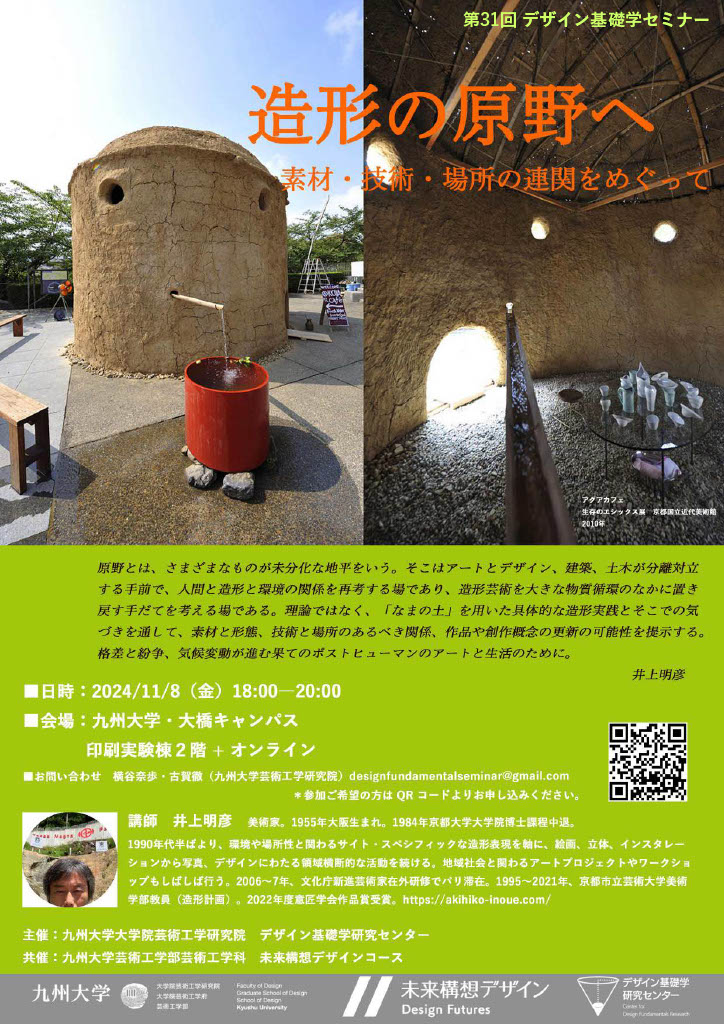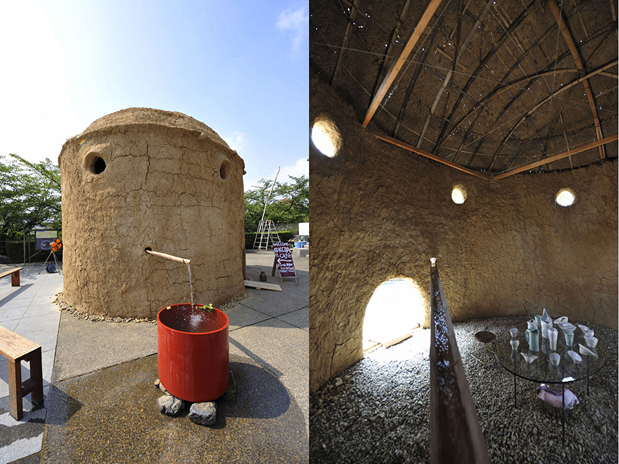The 31st Design Fundamentals Seminar: Into the primordial field:The Linkage of Material, Technique, and Place
The primordial field is a ground where different things are undifferentiated. It is a place to rethink the relationship between people, the plastic arts, and the environment, just before the separation of art, design, architecture, and civil engineering. It’s also a place to consider how the plastic arts can be brought back into the larger biogeochemical cycle. Through concrete practices with ‘fresh soil’ and the insights gained from these practices rather than theory, the project presents the potential relationship between material and form, technique and place, and the possibility of renewing the
concepts of artwork and creation toward post-human art and life at the end of advancing inequality, conflict and climate change.
Lecturer
Akihiko INOUE (Artist)
Born 1955 in Osaka, Japan; withdrew from the doctoral program at Kyoto University in 1984. Since the mid-1990s, with a focus on site-specific figurative expression in relation to the environment and place, he has continued his interdisciplinary activities, ranging from painting, sculpture and installation to photography and design. In 2006-7, he was in Paris on a Japan Agency for Cultural Affairs overseas training program for upcoming artists. From 1995 to 2021, he taught at the Faculty of Fine Arts, Kyoto City University of Arts (plastic planning), in 2022, he received the Society of Design’s Work Prize.
Date
November 8. 2024 Fri. 18:00~20:00 (Opening from 17:45~)
Venue
Printing Laboratory 2F, Kyushu Univ. Ohashi Campus + Online
*All interested parties are free to attend. If you wish to attend, please apply using this application form (lectures will be given in Japanese only).
*If you wish to participate online, the URL and other information will be sent to the address you entered in the form above on the day of the event. Please download the latest version of Zoom in advance.
Host
Center for Design Fundamentals Research, School of Design, Kyushu University
Co-host: Future Design Course, Faculty of Design, Kyushu University
Contact: Professor Toru Koga, Professor Naho Yokoya
designfundamentalseminar#gmail.com(Please replace # with @.)

Review
Akihiko Inoue explains that his art and design follow two fundamental rules: to use local materials as much as possible and to honor the images and ideas that emerge organically during the creative process. In 2010, he initiated an art project Aqua Café – Where the water flows (July 9 – August 22, 2010, Trouble in Paradise/Medi(t)ation of Survival, National Museum of Modern Art, Kyoto). For this initiative, Inoue worked on a project to build a café with mud walls in the museum’s front garden. The materials used were rich in history: soil from an Edo-period house demolished to make way for a highway, bamboo from a nearby grove, and straw. These elements were combined and shaped using water from the Lake Biwa Canal, which had played a vital role in Kyoto’s modernization.

Photography: Inoue Akihiko WS(https://akihiko-inoue.com/work/project/aqua-cafe.html)
Inoue’s work reflects a significant shift in how we perceive contemporary art and design. Traditionally, modern design has aimed for universal functionality, relying on methods and styles that can be applied anywhere, anytime. While local factors might occasionally influence design, they are often treated as obstacles to be absorbed or superficial touches—cultural accents that highlight regional characteristics.
In contrast, Inoue’s approach centers on creating something deeply tied to a specific place and time. His process doesn’t just begin with an idea of what to make; it evolves continuously, adapting with each phase of the project. To truly understand a place, you must experience it firsthand. You can’t predict what the final creation will look like until it emerges naturally from the process.
In conventional design thinking, the designer’s vision or concept governs the entire process, with the designer acting as the sole agent of creation. The focus is on the designer’s intent, prompting observers to ask, “What was the creator thinking?”
In Inoue’s practice, however, the design is shaped by the history, environment, and materials of the place. This includes elements that have been lost or forgotten. Inoue metaphorically unearths these hidden aspects, breathing new life into them and giving them a role in shaping the design. Here, the “designer” could just be the soil from an old house or the water running underground. Inoue himself acts as a medium, like a shaman, channeling the voices of the past and the essence of the materials into his work.
Why is this approach so relevant today? Modern design often overlooks the being of materials and others behind them, focusing solely on their availability in the marketplace. In the market, the origins of materials—the places they were extracted from and the people who produced them—are obscured. This detachment erodes our ability to procure it by ourselves and image the process behind. This invisibility contributes to the exploitation of nature and labor, perpetuating unsustainability.
We still depend on history, nature, and other people, even if we often fail to acknowledge this interconnectedness. The resulting sense of rootlessness permeates the modern world, leaving us feeling unmoored.
To counter this, design must be pluralized along its nature, materials, history, and (lost) human experience. It should serve as a device that recalls these intricate intersections. At Inoue’s Aqua Café, visitors experience a profound sense of grounding. Surrounded by the earthen walls, bamboo supports, and the gentle sound of flowing water, they are invited to reconnect with their roots and trace the complex lines of connection that run through the space.
(KOGA Toru)
